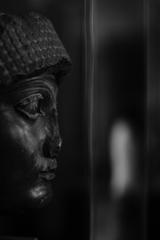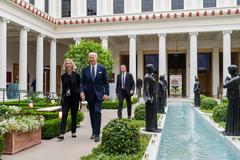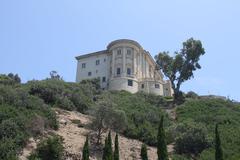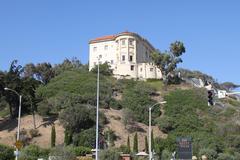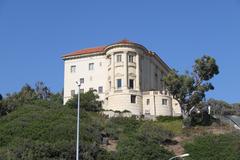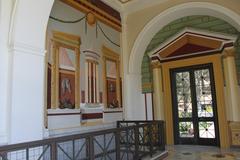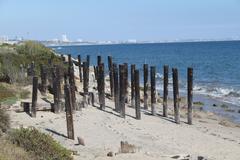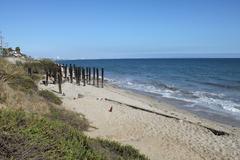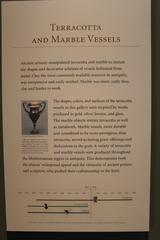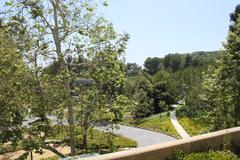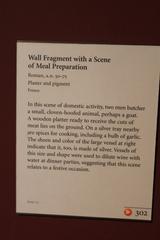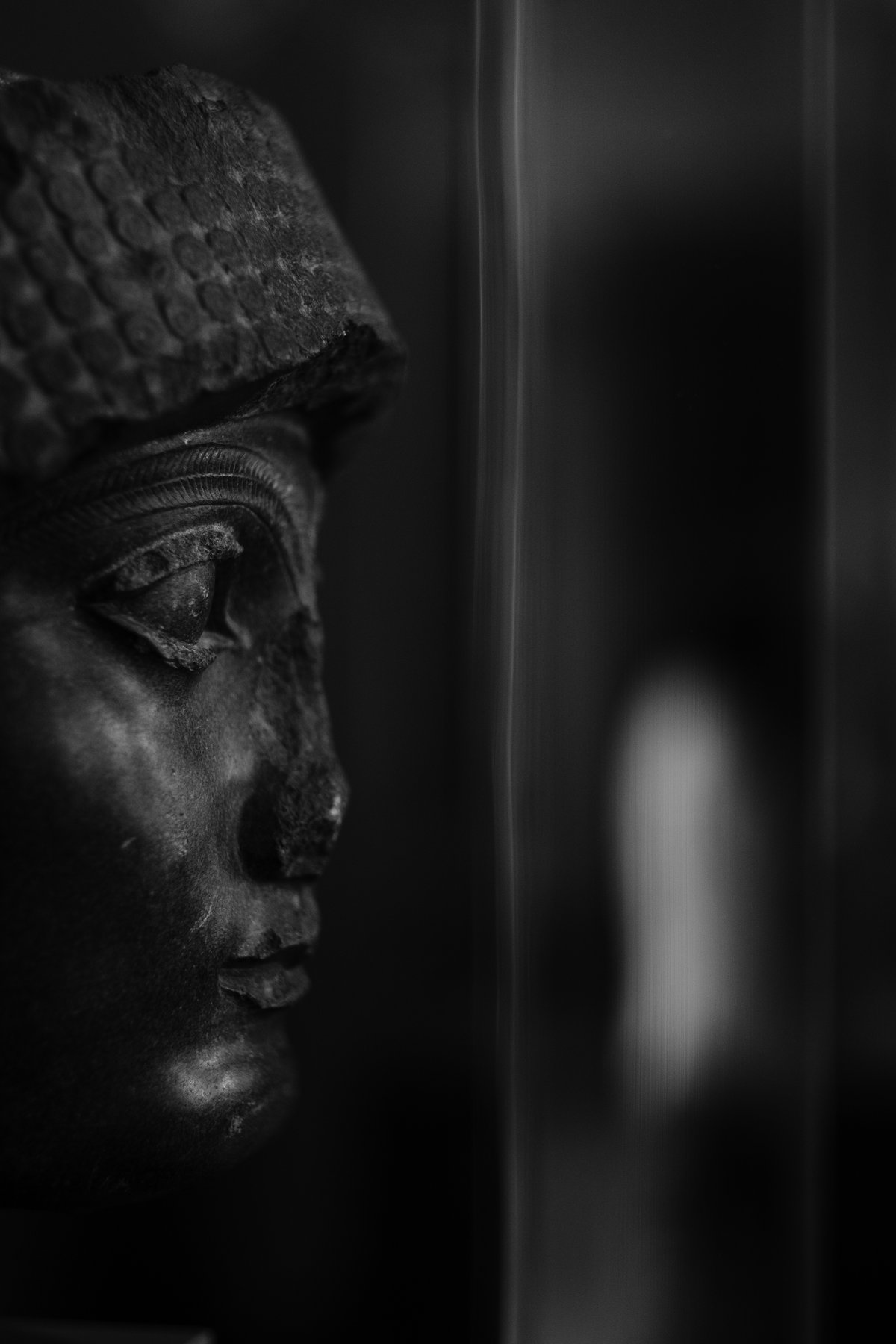
Getty Villa Visiting Hours, Tickets, and Complete Visitor Guide to This Los Angeles Historical Site
Date: 14/06/2025
Introduction
Nestled in the Pacific Palisades neighborhood of Los Angeles, the Getty Villa stands as a premier destination for anyone interested in the art, architecture, and history of the ancient Mediterranean world. With its stunning recreation of a Roman villa, world-class collection of Greek, Roman, and Etruscan antiquities, and lush Roman-inspired gardens, the Getty Villa offers an immersive experience for families, art enthusiasts, and history lovers alike. This guide covers everything you need to know about visiting hours, ticketing, accessibility, and what to expect during your visit to this iconic Los Angeles historical site (Getty Villa Official; Britannica; Luxury Travel Mag).
Table of Contents
- Origins and Vision
- Architectural Highlights
- Gardens: Living History
- Collections and Exhibitions
- Visitor Information
- Special Programs and Events
- Safety and Preservation
- FAQs
- Conclusion
- References and Official Resources
Origins and Vision
The Getty Villa was conceived by oil magnate J. Paul Getty, whose deep fascination with ancient art led him to amass an impressive collection of Greek, Roman, and Etruscan antiquities. In the 1950s, Getty opened his first gallery to the public next to his home. As his collection grew, he envisioned a dedicated museum modeled after the Villa dei Papiri—an ancient Roman country house near Herculaneum, Italy. Completed in 1974, the Getty Villa was designed to transport visitors back in time, offering not only a showcase for antiquities but also an immersive journey into the world of classical Mediterranean civilizations (Britannica; Wikipedia).
Architectural Highlights
The Getty Villa’s architecture is a meticulous homage to the Villa dei Papiri, with architects Robert Langdon and Ernest Wilson reconstructing its layout and decorative elements based on archaeological findings. The Villa features:
- Atrium: An open-ceilinged entrance hall with a sunken pool, echoing the heart of Roman domestic life.
- Peristyles: Two main columned courtyards—the Inner and Outer Peristyles—are planted with Mediterranean flora and adorned with marble statues and fountains, providing tranquil spaces for contemplation (Getty Villa Map and Guide).
- Triclinium: The formal dining room opens onto the gardens, blending indoor luxury with outdoor beauty (Getty Villa Top Things to Do).
- Temple of Hercules: Features an elaborate mosaic floor composed of imported marbles from various regions, recreating the grandeur of ancient craftsmanship.
- Entry Pavilion and Roman Roads: The main drive and entry evoke the ancient streets of Pompeii, setting the stage for a historical journey (Getty Villa Map and Guide).
For more about the Villa’s architectural story, see: (TCLF).
Gardens: Living History
The Villa’s four gardens are essential to its Roman-inspired atmosphere:
- Outer Peristyle Garden: The largest garden, featuring a long reflecting pool, statuary, and covered walkways. Statues are placed near their ancient findspots.
- Inner Peristyle Garden: A more intimate space with aromatic herbs and flowering shrubs, surrounded by Corinthian columns.
- East Garden: Known for its colorful fountain with shells and theater masks—a replica of a Pompeian feature.
- Herb Garden: Planted with fruit trees and herbs used by the Romans, offering sensory engagement with the ancient world.
These gardens are not only visually stunning but also serve as living classrooms, demonstrating the integral role of horticulture in Roman life (Getty Villa Top Things to Do; Luxury Travel Mag).
Collections and Exhibitions
The Getty Villa houses one of the world’s largest and most comprehensive collections of Greek, Roman, and Etruscan antiquities—over 44,000 objects spanning 6,500 BCE to 400 CE (History Tools).
Highlights
- “Victorious Youth”: A rare 4th-century BCE Greek bronze sculpture.
- Lansdowne Hercules: A Roman marble statue.
- Mummy Portraits: Painted funerary portraits from Roman Egypt.
- Pottery, Jewelry, and Decorative Arts: Tracing the evolution of ancient craftsmanship and daily life.
Galleries are arranged thematically and chronologically for a coherent narrative. The Villa also features rotating special exhibitions, often with international loans, such as “Ancient Thrace and the Classical World” and “Paper and Light” (LA Times).
Visitor Information
Visiting Hours
- Open: Friday through Monday, 10:00 AM–5:00 PM
- Closed: Tuesdays, New Year’s Day, Independence Day, Thanksgiving, and Christmas
- Note: Last entry is 30 minutes before closing. Always check the official website for special hours or temporary closures (Getty Villa FAQ).
Tickets and Parking
- Admission: Free, but all visitors require a timed-entry reservation. Book online at the Getty Villa website.
- Parking: On-site parking is $25 per car or motorcycle, reduced after 3 p.m., with discounts for evening events. “Pay Once, Park Twice” option allows parking at both the Getty Villa and Getty Center on the same day (Getty Villa Visitor Experience PDF).
- Public Transport: Metro Bus line 534 stops directly in front of the entrance (Travel in USA). Rideshare drop-off/pick-up is inside the property.
Accessibility and Services
- Wheelchair accessible throughout the museum and gardens.
- Wheelchairs available at the entrance.
- Service animals are welcome.
- Assistive listening devices and accessible restrooms provided.
- Family-friendly with interactive exhibits and educational programming (Getty Villa Official).
Travel Tips
- Arrive early for optimal parking and quieter galleries.
- Weekdays and shoulder seasons (April-May, September-October) are less crowded (Sweet Los Angeles).
- Bring comfortable shoes, a hat, sunscreen, water, and earbuds for audio guides.
- Download the GettyGuide® app for self-guided tours.
Dining and Shopping
- The Getty Villa Café offers Mediterranean-inspired food and outdoor seating.
- Museum Store features books, jewelry, and replicas related to the Villa’s collection (Getty Villa Official).
- No picnicking permitted on site.
Special Programs and Events
- Free guided tours offered daily, covering architecture, gardens, and collections.
- Special events include lectures, performances in the outdoor amphitheater, family workshops, and seasonal programs (Klook).
- “Garden Tea” experiences and unique workshops inspired by Roman horticulture are available with advance reservations.
Safety and Preservation
The Getty Villa is built with advanced fire-resistant construction and air filtration systems. During the January 2025 Palisades Fire, the Villa’s proactive safety measures ensured the building and collection remained unharmed, demonstrating a strong commitment to preservation (Designboom; LA Times).
FAQs
Q: What are the Getty Villa visiting hours?
A: Open Friday–Monday, 10:00 AM–5:00 PM; closed Tuesdays and major holidays.
Q: Are tickets required to visit?
A: Admission is free, but a timed-entry reservation is required for all visitors.
Q: Is parking available?
A: Yes, on-site parking is available for a fee, with discounts for late entry and programs to combine parking with the Getty Center.
Q: Is the Villa accessible?
A: Yes, with full wheelchair access, accessible restrooms, and assistive devices.
Q: Can I take photos?
A: Non-flash photography is permitted in most areas. Flash and tripods are prohibited in galleries.
Q: Are guided tours offered?
A: Yes, free guided tours and talks are available daily.
Q: Can I bring food?
A: Picnicking is not allowed. The café offers a variety of food and drink options.
Conclusion
The Getty Villa is an unparalleled destination for exploring the ancient Mediterranean world through art, architecture, and gardens. With free admission, robust accessibility services, and enriching programs, it remains a cornerstone of Los Angeles’ cultural landscape. Plan ahead by reserving your timed-entry tickets, check official resources for the latest updates, and prepare for a unique journey through antiquity.
For more information, visit the Getty Villa Official Website. Enhance your visit with the Audiala app for audio tours, and follow related articles on Los Angeles historical sites for a richer cultural experience.
